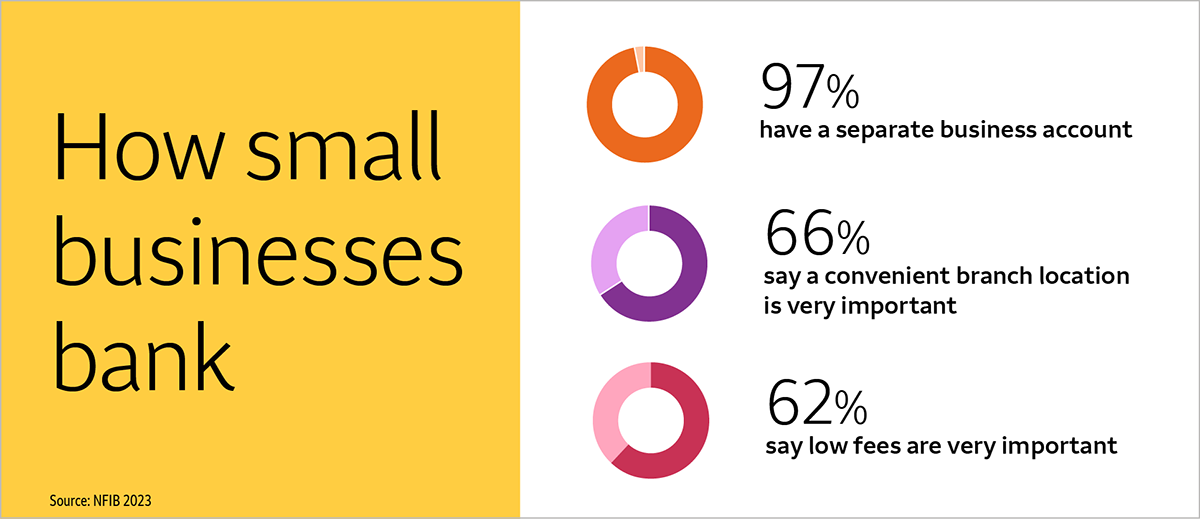Use these savvy steps to reduce banking fees for your business.
Banking fees may seem like an unavoidable cost of running your business. However, with a bit of planning and a few smart moves, you may be able to minimize them. Use these eight tips to learn more about fees, choose the products that may be right for you, and understand strategies that can potentially help reduce the banking fees your business pays.
1. Get familiar with fees.
Different types of products have different types of fees associated with them. For example, credit card and merchant services may have application fees, annual fees, processing fees, late fees, and others. Bank products like checking, savings, and certificates of deposit (CDs) may have fees if your account balance falls below a minimum requirement or processes international transactions. Be sure to read the terms and conditions of any account you are considering (found on wellsfargo.com or provided in-branch) and speak with a banker before you open an account to ensure that the product is a good fit for your business’s needs.
2. Choose the right products.
One way to minimize fees is to choose a product that meets your business needs. Consider how you’ll be using the product: checking accounts may be best for transactions, while business savings accounts may be the best for keeping cash on hand. For example, ensure your business can easily meet minimum balance requirements; otherwise a low balance could trigger maintenance fees. If your business accepts international payments, check the fee requirements for such payments to ensure you choose the best fit for your business needs.
3. Link your bank accounts.
Another way to ensure one account doesn’t incur a low-balance fee is to link your business bank accounts, when the option is available. Let’s say a cash flow shortage means that your checking account fell below the minimum required balance to avoid a maintenance fee. If you’ve got a linked savings account, the balance in that account counts toward your minimum. So, as long as the total balance in both accounts meets the overall required minimum, you won’t be charged a maintenance fee for the account with the low balance.
4. Activate account alerts.
Account alerts1 through your mobile banking app can keep you informed of account activity. As you explore the features of the Wells Fargo app, enable push notifications so you can be informed if your balance is getting low and you’re at risk of fees or overdrawing your account. Such alerts can also help keep your account safe by alerting you to transactions so you can note any suspicious activity. You may also choose to receive paperless statements to stay informed of your account activity. You’ll be notified by email whenever a new statement is ready.
5. Keep your account active.
If your business’s account doesn’t have any transactions for a certain period of time, an “inactivity” or “dormancy” fee may apply. Dormancy fee specifications may vary by state and institution. To avoid or minimize these fees, set up autopay for a small bill that you pay off every month or set a calendar alert to remind you to make a small deposit to or withdrawal from the account, especially if you don’t use it very often. Make sure your transactions meet any required minimums and that the account has enough funds to cover any payments you schedule.
6. Know your transaction limits.
Just as your account may incur fees for having too few transactions, you may find fees assessed if there are too many. Check the number of transactions each account allows per month, including types of transactions like deposits and withdrawals or wire transfers, and plan your financial activity accordingly to minimize fees.
7. Be aware of timing.
You might not think that the amount of time that you keep your money in an account matters. However, products like time accounts, also called business certificates of deposit or CDs, may require you to keep your money deposited for a specified period of time. As a result, withdrawing funds too soon may trigger a fee. Be sure you know the required timeline for time accounts and when you’re able to make fee-free withdrawals.
8. Explore overdraft protection.
Sometimes mistakes happen, and a transaction may overdraw your business account. Overdrafts can be costly. Your business may incur fees if the payment clears, leaving you with a negative balance in your account. If a payment is declined, you may incur interest or late fees as well as possibly damaging relationships with vendors. Overdraft protection is activated if your account is overdrawn, allowing the check to clear, helping your business avoid transaction delays and overdraft fees.
Your Wells Fargo banker can help you identify the various fees associated with each of your accounts and those you intend to open. Make an appointment to work with a banker to understand how to minimize fees and choose the most cost-effective account options and bank services to help your business manage expenses.
1Sign-up may be required. Availability may be affected by your mobile carrier’s coverage area. Your mobile carrier’s message and data rates may apply.









